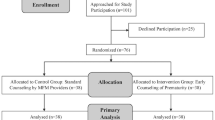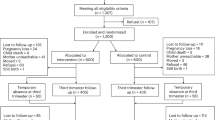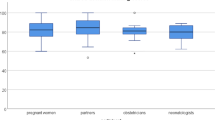Abstract
Objective:
It is common clinical practice to counsel parents expecting an early-moderate premature birth. The aim of the current study was to assess maternal knowledge of potential problems of prematurity after counseling.
Study design:
Prospective study of 49 participants admitted between 23 and 33 weeks gestation with threatened premature birth; a prematurity knowledge questionnaire and the State-Trait Anxiety Inventory were administered after counseling but before delivery.
Result:
Across all gestational-ages, participants were more aware of short-term problems than long-term problems. With increasing gestational age the knowledge of long-term problems decreased (P=0.01). Maternal knowledge was 82% for gestational ages where clear guidelines exist regarding goal of counseling and information that should be provided to the parents.
Conclusion:
Most mothers of early-moderate premature infants are not aware of the potential for long-term problems. Guidelines, which outline the information that should be provided to parents, may improve maternal knowledge after counseling.
This is a preview of subscription content, access via your institution
Access options
Subscribe to this journal
Receive 12 print issues and online access
$259.00 per year
only $21.58 per issue
Buy this article
- Purchase on Springer Link
- Instant access to full article PDF
Prices may be subject to local taxes which are calculated during checkout


Similar content being viewed by others
References
MacDonald H . American Academy of P, Committee on Fetus and N. Perinatal care at the threshold of viability. Pediatrics 2002; 110 (5): 1024–1027.
American College of Obstetricians and Gynecologists. ACOG practice bulletin: clinical management guidelines for obstetrician-gynecologists: number 38, September 2002. Perinatal care at the threshold of viability. Obstet Gynecol 2002; 100 (3): 617–624.
Dobak WJ, Gardner MO . Late preterm gestation: Physiology of labor and implications for delivery. Clin Perinatol 2006; 33 (4): 765–776, abstract.
Marret S, Ancel P, Marpeau L, Marchand LM, Pierrat V, Larroque B et al. Neonatal and 5-year outcomes after birth at 30-34 weeks of gestation. Obstet Gynecol 2007; 110 (1): 72–80.
Chyi LJ, Lee HC, Hintz SR, Gould JB, Sutcliffe TL . School outcomes of late preterm infants: Special needs and challenges for infants born at 32 to 36 weeks gestation. J Pediatr. 2008; 153 (1): 25–31.
Lindstrom K, Lindblad F, Hjern A . Psychiatric morbidity in adolescents and young adults born preterm: a Swedish national cohort study. Pediatrics 2009; 123 (1): e47–e53.
Guillén Ú, Suh S, Munson D, Posencheg M, Truitt E, Zupancic JAF et al. Development and pretesting of a decision-aid to use when counseling parents facing imminent extreme premature delivery. J Pediatr 2011; 160 (3): 382–387.
Harrison H . The principles for family-centered neonatal care. Pediatrics 1993; 92 (5): 643–650.
Kumar D, Sanders L, Perrin EM, Lokker N, Patterson B, Gunn V et al. Parental understanding of infant health information: Health literacy, numeracy, and the parental health literacy activities test (PHLAT). Acad Pediatr 2010; 10 (5): 309–316.
Yin HS, Johnson M, Mendelsohn AL, Abrams MA, Sanders LM, Dreyer BP . The health literacy of parents in the United States: A nationally representative study. Pediatrics. 2009; 124, (Supplement 3): S289–S298.
Ling ZJ, Lian WB, Ho SK, Yeo CL . Parental knowledge of prematurity and related issues. Singapore Med J 2009; 50 (3): 270–277.
Zupancic JAF, Kirpalani H, Barrett J, Stewart S, Gafni A, Streiner D et al. Characterising doctor-parent communication in counselling for impending preterm delivery. Arch Dis Child Fetal Neonatal Ed 2002; 87 (2): F113–F117.
Section on Ophthalmology, American Academy of Pediatrics, American Academy of Ophthalmology, American Association for Pediatric Ophthalmology and Strabismus. Screening examination of premature infants for retinopathy of prematurity. Pediatrics 2006; 117 (2): 572–576.
Bhat V, Karam M, Saslow J, Taylor H, Pyon K, Kemble N et al. Utility of performing routine head ultrasounds in preterm infants with gestational age 30–34 weeks. J Matern Fetal Neonatal Med 2012; 25 (2): 116–119.
Spielberger C, Gorsuch R, Lushene R . STAI manual for the state-trait anxiety inventory. Consulting Psychologists Press Inc: Palo Alto, CA, 1970.
Gunning MD, Denison FC, Stockley CJ, Ho SP, Sandhu HK, Reynolds RM . Assessing maternal anxiety in pregnancy with the state-trait anxiety inventory (STAI): issues of validity, location and participation. J Reprod Infant Psychol 2010 08; 28 (3): 266–273.
Davidoff MJ, Dias T, Damus K, Russell R, Bettegowda VR, Dolan S et al. Changes in the gestational age distribution among U.S. singleton births: Impact on rates of late preterm birth, 1992 to 2002. Semin Perinatol 2006; 30 (1): 8–15.
MacDorman MF, Declercq E, Zhang J . Obstetrical intervention and the singleton preterm birth rate in the united states from 1991-2006. Am J Public Health 2010; 100 (11): 2241–2247.
Gyamfi-Bannerman C, Fuchs KM, Young OM, Hoffman MK . Nonspontaneous late preterm birth: Etiology and outcomes. Obstet Gynecol 2011; 205 (5): 456.e1–e6.
Kramer MS . Late preterm birth: Appreciable risks, rising incidence. J Pediatr 2009; 154 (12): 159–160.
Kuehn BM . Scientists probe the role of clinicians in rising rates of late preterm birth. JAMA 2010; 303 (12): 1129–1136.
Talge NM, Holzman C, Wang J, Lucia V, Gardiner J, Breslau N . Late-preterm birth and its association with cognitive and socioemotional outcomes at 6 years of age.(Editorial). Obstet Gynecol Surv 2011; 66 (4): 193–195.
Muthusamy AD, Leuthner S, Gaebler-Uhing C, Hoffmann RG, Li S, Basir MA . Supplemental written information improves prenatal counseling: a randomized trial. Pediatrics 2012; 129 (5): e1269–e1274.
Cooper-Patrick L, Gallo JJ, Gonzales JJ, Vu HT, Powe NR, Nelson C et al. Race, gender, and partnership in the patient-physician relationship. JAMA 1999; 282 (6): 583–589.
Johnson RL, Roter D, Powe NR, Cooper LA . Patient race/ethnicity and quality of patient-physician communication during medical visits. Am J Public Health 2004; 94 (12): 2084–2090.
Ghia N, Spong CY, Starbuck VN, Scialli AR, Ghidini A . Magnesium sulfate therapy affects attention and working memory in patients undergoing preterm labor. Obstet Gynecol 2000 10; 183 (4): 940–944.
American College of Obstetricians and Gynecologists Committee on Obstetric Practice; Society for Maternal-Fetal Medicine. Committee opinion no. 455: Magnesium sulfate before anticipated preterm birth for neuroprotection. Obstet Gynecol 2010; 115 (3): 669–671.
Author information
Authors and Affiliations
Corresponding author
Ethics declarations
Competing interests
The authors declare no conflict of interest.
Rights and permissions
About this article
Cite this article
Govande, V., Brasel, K., Das, U. et al. Prenatal counseling beyond the threshold of viability. J Perinatol 33, 358–362 (2013). https://doi.org/10.1038/jp.2012.129
Received:
Revised:
Accepted:
Published:
Issue Date:
DOI: https://doi.org/10.1038/jp.2012.129
Keywords
This article is cited by
-
Parental understanding of crucial medical jargon used in prenatal prematurity counseling
BMC Medical Informatics and Decision Making (2020)
-
Preferred prenatal counselling at the limits of viability: a survey among Dutch perinatal professionals
BMC Pregnancy and Childbirth (2018)
-
Reply to Govande et al. Prenatal counseling beyond the threshold of viability
Journal of Perinatology (2013)
-
Reply to Stokes and Watson
Journal of Perinatology (2013)



